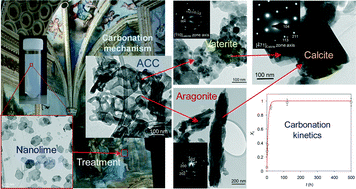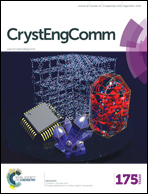Amorphous and crystalline calcium carbonate phases during carbonation of nanolimes: implications in heritage conservation†
Abstract
Nanolimes are alcohol dispersions of colloidal Ca(OH)2 nanoparticles used as novel nanomaterials for the conservation of cultural heritage. Upon exposure to atmospheric CO2 at room T, and in the presence of H2O, they undergo carbonation forming CaCO3 cement which consolidates decayed porous materials such as stone or mural paintings. Despite extensive research on the synthesis and applications of nanolimes, little is known about the mechanisms and kinetics of the formation and transformation of metastable and stable calcium carbonate phases and their effects on the treatment efficacy. This is a strong handicap to their effective and widespread application. Here we show that the carbonation of nanolimes in humid air at room T involves the initial formation of amorphous calcium carbonate (ACC) and its transformation into metastable vaterite (and minor aragonite) via a dissolution–precipitation process, followed by non-classical nanoparticle-mediated crystal growth. Subsequently, vaterite (and aragonite) partially dissolves and stable calcite precipitates. All these phase transformations follow first order kinetics, where the rate controlling step is the amount of undissolved parent phase. We unambiguously demonstrate that precipitation of vaterite (up to ∼35 wt%) and aragonite (∼5 wt%) after ACC (up to ∼24 wt%) is favored by the alcohol adsorbed on Ca(OH)2 nanoparticles undergoing carbonation. Although it is known that vaterite formation limits consolidation, the fast kinetics of the solvent-mediated vaterite–calcite transformation (72% conversion in ten days) ensures that, in the short-term, the almost full consolidation potential of nanolimes can be achieved. Finally, the mechanistic and kinetic commonalities between nanolime carbonation and biomineralization/biomimetic synthesis of CaCO3 underline that the observed multistep crystallization and non-classical crystal growth might be general and applicable for the rational design of novel CaCO3 materials.


 Please wait while we load your content...
Please wait while we load your content...